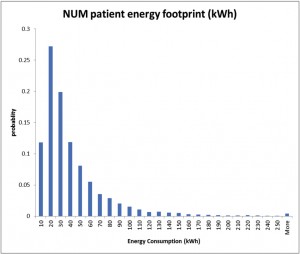Clean Med Europe 2013
Professor Bacon has just returned from CleanMed Europe where he presented our latest work on the energy and carbon analysis of patient pathways in acute hospitals. For those readers who are unfamiliar with this concept, it is a means for analysis of the patient journey both to and through a hospital, as well as the return journey to their home. Our current focus concerns the journey through a hospital as it relates to each different type of Outpatient visit.
You will find a poster about our work here.
What is the value of such an analysis?
The simple answer is that it provides the clincians in the hospital with a whole new understanding of how their working practices impact energy consumption and carbon emissions.
But what prevents clinicians from gaining this understanding today?
Essentially, it is because many measures of energy consumption and carbon emissions use metrics that are often difficult to comprehend in real-life. For example, the current Department of Health measure of energy is expressed as GJ/100m3 – for a clinical user what does this mean? Another unit of measurement is kWh/m2 – again this is not easy to understand, particulary for a clinical user. Here at Conclude we believe that we need measures that clinicians are able to directly relate to – measures that mean something to them in terms of their working practices. This is the reason for the focus on the patient pathway. We believe that clinicians need to understand the energy and carbon impacts of their working practices, and that if they do understand them, they maybe be more inclined to change them. Well that is the theory!
So what is The Conclude Consultancy doing about this?
It is for these reasons that at Conclude we are developing a methodology and a measurement protocol to enable the energy and carbon impacts of each patient pathway to be understood. It goes without saying that each patient will expect the internal environment of the hospital to be comfortable. In terms of their environmental comfort needs, one patient type may have substantially less tolerance than another, such that some will require more heating or less cooling than another. Others will make demands on hi-tech equipment, which could make large demands on electrical consumption. These examples point to the need to understand the different energy needs and carbon emission consequences of each patient pathway through the hospital. In being able to directly corelate the energy consumption and carbon emissions with each pathway, and with the associated patient type, we will be able to build a database of performance data for each.
We believe that for the first time clincians will not only be able to access performance measures that they can directly relate to, but it will also enable them to test alternative working practices and so drive down energy consumption and the associated carbon emissions. Central to achieving this objective is our work on Whole Facility Energy Modelling and Occupancy Analytics. We also believe that without the detailed analysis that we are able to provide it will be very difficult to measure energy and carbon performance in the way that we have described.
What have you discovered so far?
We have developed the means to directly corelate energy consumption at each hour of the day to every part of the hospital. We know what processes impact what energy consumption. We understand how major equipment use impacts consumption, and the scenarios for the different modes of imaging equipment operation that would reduce consumption. We understand how clinical user intervention in the controls for heating, cooling, ventilation and lighting can impact consumption. These insights are the basis for understanding the energy and carbon impacts of each patient pathway.

For each Outpatient episode in Nuclear Medicine there is a 70% probability that the episode will consume no more than 40 kWh of energy.
We will be publishing further results over the next few months, as we make new discoveries! One area that we are particularly interested in concerns the relative benefit of distributed clincial services in the community – de-centralised from the acute hospital. What impacts would this have on energy consumption and carbon emissions? What would the operational benefits be? What are the conflicts?
Tweet This
Follow us
on Twitter